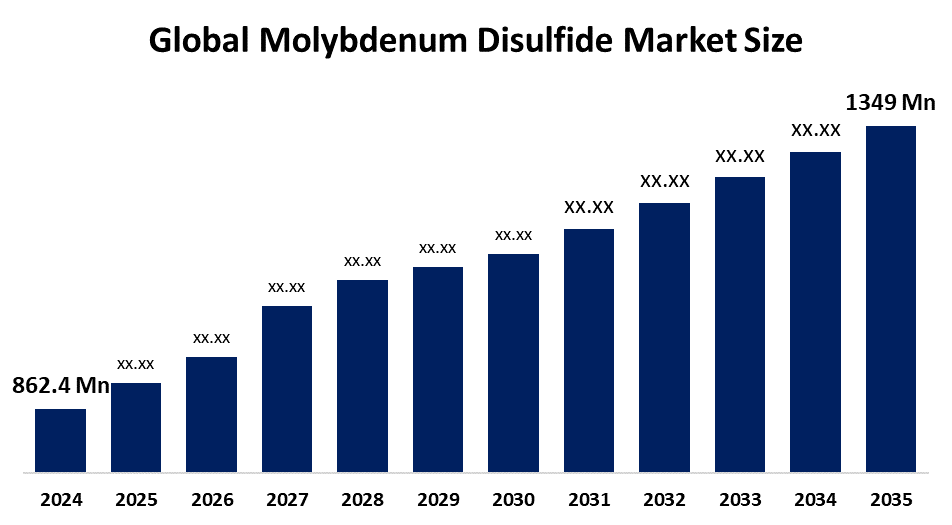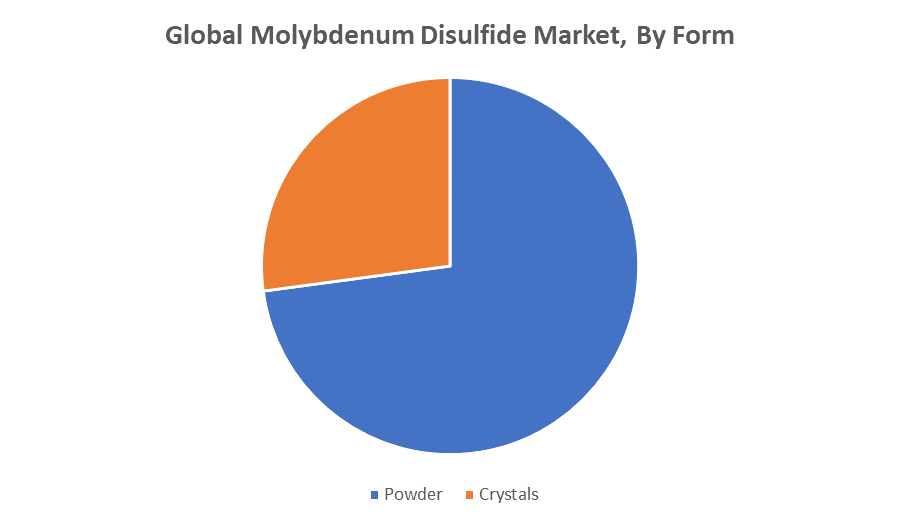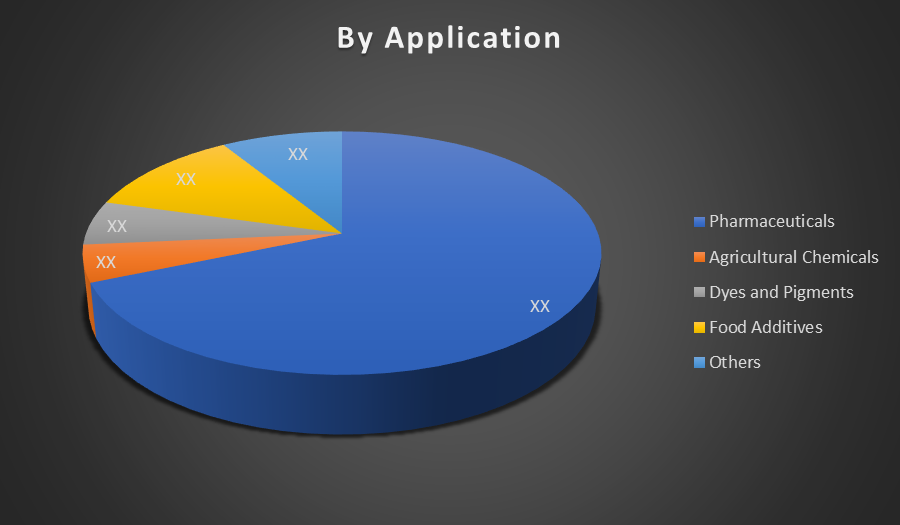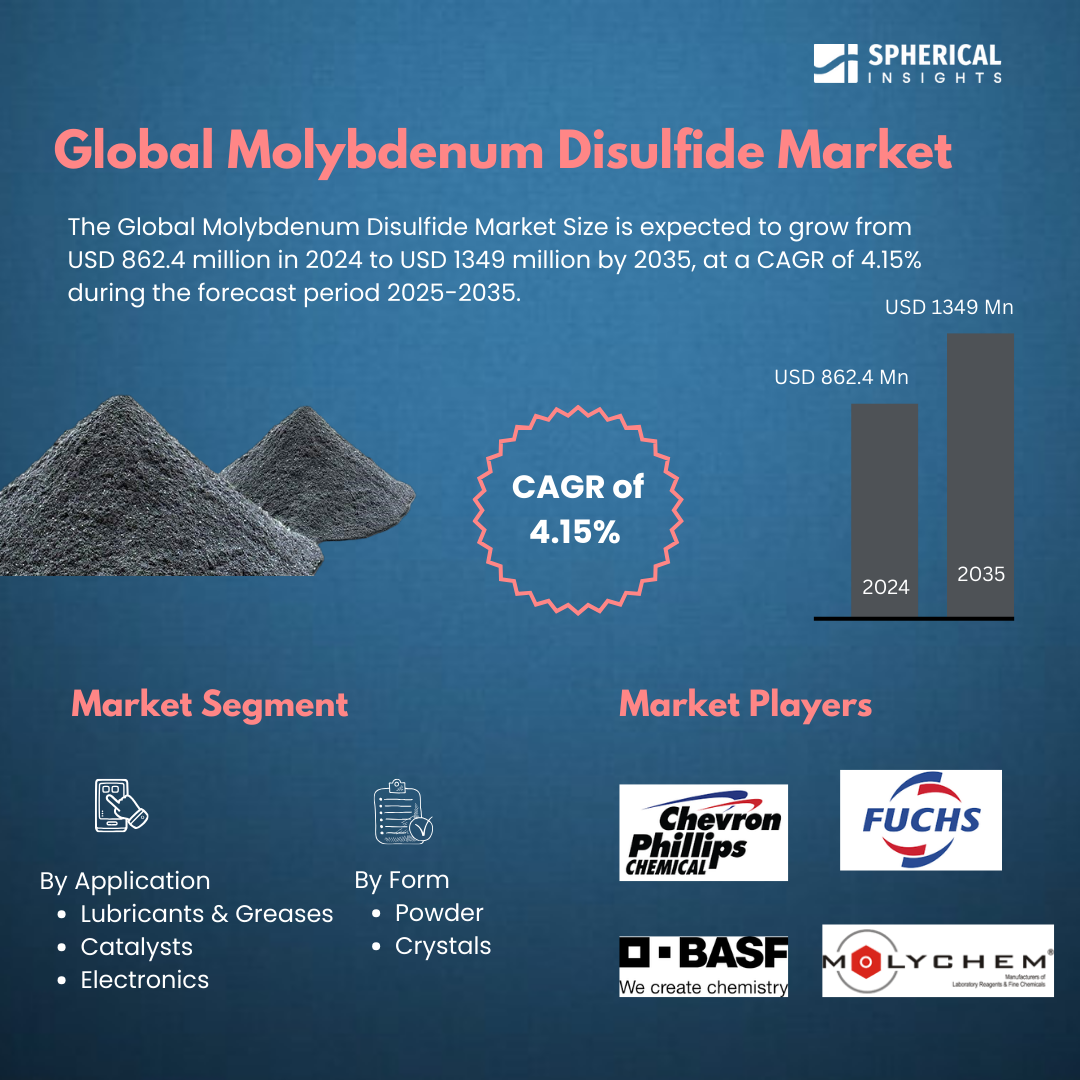Global Molybdenum Disulfide Market Insights Forecasts to 2035
- The Global Molybdenum Disulfide Market Size Was Estimated at USD 862.4 Million in 2024
- The Market Size is Expected to Grow at a CAGR of around 4.15% from 2025 to 2035
- The Worldwide Molybdenum Disulfide Market Size is Expected to Reach USD 1349 Million by 2035
- Europe is Expected to Grow the fastest during the forecast period.

Molybdenum Disulfide Market
The molybdenum disulfide market is centered around the production and application of a versatile inorganic compound known for its unique physical and chemical properties. MoS is a solid lubricant and a key material in various industrial processes due to its layered structure, which enables low friction and high resistance to heat and wear. It is widely used in industries such as automotive, aerospace, electronics, and machinery manufacturing. In addition to its traditional role as a lubricant additive, molybdenum disulfide is also utilized in coatings, greases, and as a catalyst in chemical processing. The material's semiconducting properties have led to its exploration in advanced technologies, including flexible electronics and nanomaterials. Available in both natural and synthetic forms, MoS can be processed into powders, pastes, and dispersions depending on the application requirements. The market includes a range of stakeholders, from raw material suppliers and chemical processors to end-use industries across the globe.
Attractive Opportunities in the Molybdenum Disulfide Market
- Molybdenum disulfide’s high surface area and chemical reactivity make it ideal for water purification and gas sensing technologies. It can effectively detect and remove pollutants, offering a sustainable solution to environmental challenges. Growing environmental awareness and regulatory pressures are driving demand for such advanced materials in pollution control.
- MoS is gaining attention in biomedical research for drug delivery systems and bioimaging due to its excellent biocompatibility and adjustable surface chemistry. These properties allow for targeted therapies and improved imaging techniques, potentially revolutionizing treatment methods. This opens new avenues for MoS beyond industrial uses into healthcare innovation.
- Incorporating MoS into 3D printing materials and advanced composites can enhance strength, durability, and thermal stability, especially for aerospace and defense applications. This helps create lighter, stronger components while reducing manufacturing costs. The growing adoption of additive manufacturing makes this a promising growth area.
- MoS catalytic properties are critical for hydrogen production and fuel cell technologies, particularly in hydrogen evolution reactions (HER). As the world shifts toward clean energy, MoS offers a cost-effective and efficient catalyst alternative. This opportunity aligns with global trends in renewable energy and electrification efforts.
Global Molybdenum Disulfide Market Dynamics
DRIVER: Growing demand for high-performance lubricants in automotive
One of the primary drivers is the growing demand for high-performance lubricants in automotive, aerospace, and heavy machinery sectors, where MoS is valued for its excellent friction-reducing and wear-resistant properties. Additionally, the rapid advancement in electronics and nanotechnology has increased the use of MoS as a semiconductor material in transistors, sensors, and flexible electronic devices. Its role in energy storage systems, particularly in lithium-ion batteries and supercapacitors, is also expanding due to its ability to enhance conductivity and energy density. The material’s catalytic properties are gaining importance in the chemical and petrochemical industries, supporting its broader industrial adoption. Furthermore, increasing investments in renewable energy technologies and electric vehicles are fueling research and development in MoS based components. These technological developments, combined with industrial growth in emerging markets, continue to propel demand for molybdenum disulfide globally.
RESTRAINT: High cost of production, especially for synthetic and high-purity grades
High cost of production, especially for synthetic and high-purity grades used in electronics and advanced materials. This limits its widespread adoption in cost-sensitive industries. Additionally, the complex and energy-intensive extraction and processing methods can raise environmental concerns and regulatory scrutiny. Limited availability of high-quality molybdenum ore in certain regions also contributes to supply chain constraints. In electronic and nanotechnology applications, MoS competes with more established materials like graphene and silicon, which already have well-developed infrastructure and commercial scalability. Moreover, there are technical challenges in large-scale integration of MoS into devices, particularly in maintaining consistent material properties during fabrication. These issues, coupled with a lack of awareness among smaller end users and limited standardization in product quality, may slow down the commercial expansion of the MoS market.
OPPORTUNITY: Potential use in environmental applications
One key area is its potential use in environmental applications, such as water purification and gas sensing, where MoS high surface area and chemical reactivity can be leveraged for pollutant detection and removal. Additionally, MoS is being explored in biomedical fields for drug delivery systems and bioimaging due to its biocompatibility and tunable surface properties. The development of 3D printing materials and advanced composites incorporating MoS could open new markets in aerospace and defense. Furthermore, increased interest in hydrogen production and fuel cells offers opportunities for MoS as a cost-effective catalyst in hydrogen evolution reactions (HER). Collaborations between academic institutions and industries for research commercialization could also accelerate the material’s entry into niche sectors. These emerging applications highlight the broader potential of MoS beyond traditional uses, offering growth avenues for innovation and market diversification.
CHALLENGES: Scalability of advanced MoS applications
The molybdenum disulfide (MoS) market faces several challenges beyond production costs and material competition. One significant challenge lies in the scalability of advanced MoS applications, especially in electronics and energy storage, where consistent large-scale synthesis with uniform quality remains difficult. Additionally, integration of MoS into existing manufacturing systems and supply chains requires specialized equipment and processes, posing barriers for widespread industrial adoption. Intellectual property (IP) and patent limitations also present hurdles, as much of the innovative work around MoS is held by academic or research institutions, restricting open commercial development. Another challenge is the limited availability of skilled professionals and technical expertise required for working with 2D materials, which can slow innovation and implementation. Moreover, the long validation cycles in sectors like aerospace, medical, and automotive delay the adoption of new materials such as MoS. These challenges collectively affect the pace at which MoS based technologies can transition from lab to market.
Global Molybdenum Disulfide Market Ecosystem Analysis
The global molybdenum disulfide market ecosystem comprises raw material suppliers, manufacturers, technology developers, distributors, and end-use industries. Raw molybdenum is mined and processed into MoS by manufacturers, then distributed globally for use in lubricants, electronics, energy storage, and catalysts. Research institutions drive innovation, while regulatory bodies oversee environmental and safety standards. The ecosystem thrives on collaboration between industry and academia, with emerging technologies and sustainability trends influencing its growth and structure. This interconnected network supports the development and commercialization of MoS across diverse applications and regions.
Based on the form, the powdered molybdenum disulfide segment dominated the molybdenum disulfide market over the forecast period

The dominance is attributed to its widespread use across various industries, particularly in lubricants, coatings, and greases. Powdered MoS offers excellent thermal stability, low friction, and high wear resistance, making it ideal for heavy-duty and high-temperature applications. Its ease of handling, blending compatibility with other materials, and cost-effectiveness further contribute to its preference over other forms such as pastes or dispersions. The growing demand in automotive, aerospace, and industrial machinery sectors continues to reinforce the powdered form's market leadership.
Based on the application, the lubricants & greases segment dominated the molybdenum disulfide market over the forecast period

MoS is highly valued in this segment for its superior lubricating properties, particularly under extreme pressure and temperature conditions where conventional lubricants fail. Its ability to reduce friction and wear makes it essential in automotive, aerospace, and industrial machinery applications. The powdered form of MoS is commonly added to greases, oils, and coatings to enhance performance and equipment lifespan. As industries increasingly prioritize efficiency and durability, the demand for MoS based lubricants has remained strong, securing this segment’s leading position.
Asia Pacific is anticipated to hold the largest market share of the molybdenum disulfide market during the forecast period
Asia Pacific is anticipated to hold the largest market share of the molybdenum disulfide market during the forecast period. This dominance is driven by the region’s strong industrial base, including automotive, aerospace, electronics, and manufacturing sectors. Countries like China and India are key contributors due to their large-scale production, technological advancements, and increasing adoption of MoS in lubricants, semiconductors, and energy storage applications. Additionally, ongoing investments in infrastructure development and renewable energy projects further boost demand. The availability of raw materials and growing research activities also support market growth in the region, making Asia Pacific the leading hub for MoS consumption globally.
Europe is expected to grow at the fastest CAGR in the molybdenum disulfide market during the forecast period
Europe is expected to grow at the fastest CAGR in the molybdenum disulfide market during the forecast period. This rapid growth is driven by the region’s strong focus on advanced automotive technologies, aerospace innovations, and the increasing adoption of MoS in electronics and energy storage applications. Strict environmental regulations in Europe are encouraging the use of high-performance, eco-friendly lubricants and materials, boosting demand for MoS based products. Additionally, significant investments in research and development, along with government initiatives supporting clean energy and sustainable manufacturing, are accelerating market expansion. The presence of key industry players and technological advancements further contribute to Europe’s dynamic growth trajectory in the MoS market.
Key Market Players
KEY PLAYERS IN THE MOLYBDENUM DISULFIDE MARKET INCLUDE
- Chevron Phillips Chemical Company LLC
- FUCHS Group
- BASF SE
- Lubrizol Corporation
- MolyChem
- Koch Minerals & Trading
- Wuxi Qingqing Lubricant Technology Co., Ltd.
- NGK Insulators, Ltd.
- Hangzhou Way Chemical Technology Co., Ltd.
- Molycorp
- Others
Market Segment
This study forecasts revenue at global, regional, and country levels from 2020 to 2035. Spherical Insights has segmented the molybdenum disulfide market based on the below-mentioned segments:
Global Molybdenum Disulfide Market, By Form
Global Molybdenum Disulfide Market, By Application
- Lubricants & Greases
- Catalysts
- Electronics
Global Molybdenum Disulfide Market, By Regional Analysis
- North America
- Europe
- Germany
- UK
- France
- Italy
- Spain
- Russia
- Rest of Europe
- Asia Pacific
- China
- Japan
- India
- South Korea
- Australia
- Rest of Asia Pacific
- South America
- Brazil
- Argentina
- Rest of South America
- Middle East & Africa
- UAE
- Saudi Arabia
- Qatar
- South Africa
- Rest of the Middle East & Africa






